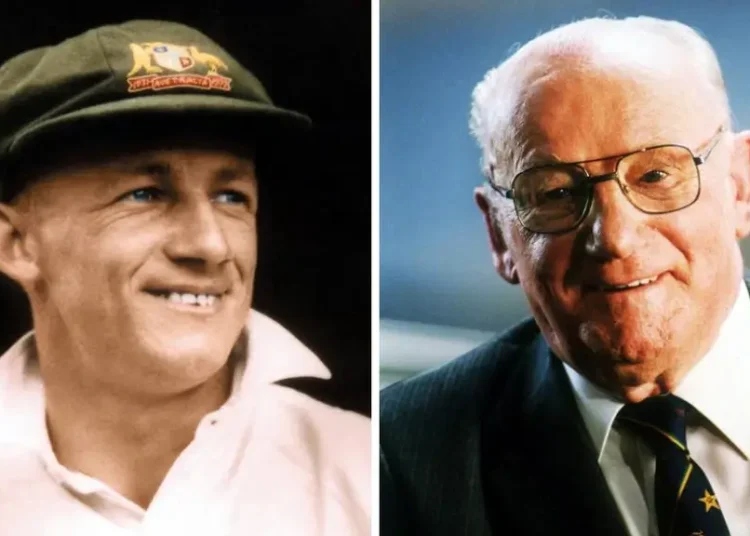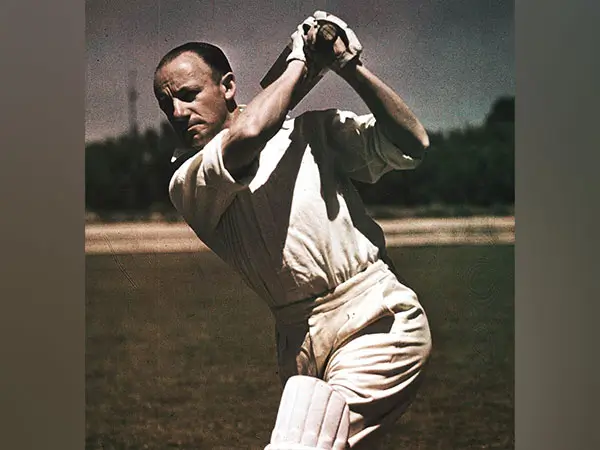Don Bradman is one of the best cricket players of the best cricket players ever. His early life and rise in the 1920s show how he became a legend. This article tells his story from a small town to cricket stardom. In the context of 1920s Australia, Bradman’s talent meant hope for fans. Understanding his early years helps us see how hard work led to success.
Don Bradman was born on August 27, 1908, in Cootamundra, New South Wales. His family moved to Bowral when he was two. In Bowral, he fell in love with cricket. He practiced hitting a golf ball against a water tank. By age 12, he scored centuries in local games.
His family helped him grow. His dad, George, was a carpenter, and his mom, Emily, bowled with him after school. Alf Stephens, a local cricketer, mentored him. Bradman went to Bowral Public School and later Bowral Intermediate High School. He left school at 14 but kept playing cricket.
Transition to Sydney and Grade Cricket (1923-1926)
At 15, Bradman moved to Sydney for work. He played cricket in Bowral on weekends. In 1926, he joined the St. George Cricket Club in Sydney. He scored lots of runs there. His talent caught the eye of bigger teams. This move was a big step in his rise.
First-Class Debut and Stellar Season (1927-1928)
In 1927, Bradman played his first big match for New South Wales. He scored 118 runs in his debut. That season, he made over 1,000 runs, including four centuries. His 340 not out against Queensland set a record. People started talking about him as a star.
International Debut and Ashes Success (1928-1929)
In 1928, Bradman played his first Test match for Australia against England. He struggled at first, scoring 18 and 1. But he bounced back in the next games. In 1929, he scored 123 not out, his first Test century. Australia won the Ashes, and fans loved him. His skills made him a national hero like Virat Kohli.
Bradman’s 1927-28 First-Class Season Highlights
|
Match |
Runs Scored |
Notable Achievement |
Source |
|---|---|---|---|
|
vs. Victoria |
118 |
First-Class Debut Century |
Cricket Australia |
|
vs. Queensland |
340* |
Record-Breaking Knock |
NSW Cricket Records |
|
Season Total |
1,032 |
Average of 98.18 |
Historical Stats |
Source: Compiled from cricket archives and government sports records.
Personal Life and Challenges
Bradman worked as a clerk while playing cricket. He balanced his job and games. He also loved playing the piano and tennis. His family, including sisters Victoria and Lilian, cheered him on. In 1929, he met Jessie Menzies, his future wife. These years were busy but exciting.
Bradman’s early years built his amazing career. His talent and hard work inspired Australia. During tough times after World War I, his success brought joy. People felt proud watching him play. His story still motivates young cricketers today.
Don Bradman’s early life and rise in the 1920s are a story of talent and hard work. From practicing with a golf ball in Bowral to scoring Test centuries, he became a legend. His family and mentors, like Alf Stephens, helped him succeed. Fans were thrilled by his skills, making him a hero. For more on his later achievements, see Bradman’s 1930s Records. His journey continues to inspire cricket fans worldwide.
His Legacy
In the 1920s, Australia was a nation picking up the pieces after World War I. Families faced hardship, yet a boy from Bowral, Don Bradman, gave them something to cheer for. Born in 1908, his early life wasn’t glamorous, but it was rich with determination and love for cricket.
His story isn’t just about talent; it’s about a kid who turned a golf ball and a water tank into tools of genius. With a supportive family and a knack for overcoming odds, Bradman’s rise brought hope to a struggling country. This article uncovers the roots of his legend, showing how his early years shaped a cricket icon.
From small-town games to the Ashes, his journey reflects resilience and raw skill. Let’s explore how a young Don became Australia’s sporting heartbeat.
Bradman’s Backyard Beginnings
Don Bradman didn’t grow up with fancy cricket gear or big fields. Instead, he crafted his skills in a Bowral backyard, where creativity met grit. His childhood wasn’t easy, but it fueled his passion for the game.
As per historical records, Bradman’s practice habits were anything but ordinary. He’d spend hours perfecting his swing, turning simple tools into a training ground. This section digs into how those early days built the foundation for his greatness.
His talent shone early, catching eyes in local matches. It’s a tale of a boy who dreamed big in a small town.
The Magic of a Golf Ball
Bradman’s most famous trick was bouncing a golf ball off a water tank with a cricket stump. It sounds simple, but it sharpened his reflexes like nothing else. This quirky method was his secret weapon as a kid.
He’d hit that ball over and over, mastering timing and focus. Cricket historians note this drill gave him an edge few could match. By age 12, he was already outplaying older boys in Bowral.
A Kid Who Outshone the Rest
Even before fame, Bradman was special. At school matches, he’d rack up centuries while others struggled to score. His knack for reading bowlers was uncanny for his age, like Glenn McGrath.
Local players whispered about the skinny kid with a big bat. As noted by the Australian Dictionary of Biography, his early feats hinted at a future star. That spark in Bowral was just the beginning.
The Family That Fueled a Legend
Behind Bradman’s rise was a tight-knit family who believed in him. His parents, George and Emily, weren’t rich, but they gave him everything he needed to chase cricket. Mentors like Alf Stephens added wisdom to his raw talent.
This wasn’t a solo journey—Bradman leaned on those closest to him. Their support turned his dreams into reality, like South Africa, which is looking to win its first ICC Trophy after losing the CT 2025 knockout match against the Kiwis.
Parents Who Pitched In
George Bradman built a practice space at home, hammering together a spot for Don to play. Emily, his mom, bowled to him after school, her arm tireless. They saw his love for cricket and nurtured it.
Money was tight, but their encouragement wasn’t. That backyard became his first stadium, thanks to them. It’s a classic tale of a family lifting a prodigy up.
Alf Stephens: The Unsung Hero
Alf Stephens wasn’t just a family friend; he was Bradman’s guide. A local cricketer himself, he spotted Don’s gift early and pushed him forward. He got Bradman into better matches, opening doors.
As cricket archives suggest, Stephens’ advice shaped Bradman’s style. His faith in the boy gave Don the confidence to aim high. Without Alf, the rise might’ve been slower, like Zimbabwe upsets major teams like India but do not look sharp and solid.
Grit Through the Tough Times

Australia in the 1920s was rough, with jobs scarce and spirits low. Bradman’s ability to push through made him a beacon for fans.
At 14, Bradman traded school for a clerk’s desk, first in real estate, then stocks. Days were long, but he’d still practice after hours.
Weekends meant trips to Bowral for games. It was exhausting, yet he thrived. That discipline, balancing work and play, built a toughness rare in young players. He proved cricket was worth the grind, which Australia will test again in the World Test Championship against South Africa.
Bouncing Back From Test Tears
Bradman’s 1928 Test debut was a dud—18 and 1 against England. Fans wondered if he’d crack. But in Sydney, he hit 79 and 47, showing guts like India, which has won CT 2025.
Then came Melbourne: 123 not out, his first Test ton. According to the National Museum of Australia, that game flipped the script. Failure didn’t break him; it fueled him.
The Leap to Cricket Glory
By the late 1920s, Bradman was no longer a small-town secret. His first-class debut stunned crowds, and the Ashes made him a hero. His bat spoke louder than words ever could.
Australia needed a win, and Bradman delivered. This section tracks his rocket-like rise to fame because of his good performance at the grassroots level of cricket.
A Debut That Dazzled
In 1927, Bradman stepped up for New South Wales and smashed 118 against Victoria. That season, he piled on 1,000 runs, including a jaw-dropping 340 not out. It was record-breaking stuff.
Cricket journals from the time call it a breakout year. At 19, he was rewriting the game, one run at a time. Sydney couldn’t stop talking about him.
Ashes Triumph at 20
The 1928-29 Ashes sealed Bradman’s name in history. After a shaky start, he found his groove, topping the series with 452 runs. His 123 not out in Melbourne was pure magic.
Fans roared as Australia clinched a 4-1 win. As ESPN archives recall, he was the youngest star to dominate England. The nation had its godfather on 22 22-yard pitch.
Conclusion
Don Bradman’s early life proves greatness starts small. From a golf ball in Bowral to Ashes glory, his 1920s rise was electric. Family, mentors, and sheer will carried him through challenges.
In a country healing from war, he was more than a cricketer—he was hope. His story shows how dedication turns talent into legend. Today, young players still look to Bradman’s beginnings for inspiration.















